#great moravia
Text
Collection of Old Church Slavonic texts in PDFs
I've been collecting Old Church Slavonic texts that have been dated to the 9th and 10th century Great Moravia and the First Bulgarian Empire, and reconstructed to as close to the original as possible with restored orthography, since most surviving copies are from much younger manuscripts and some details might have been lost in transmission and changes to the orthography.
LINK (Google Drive folder)
All files with (g) at the end also contain text in the Glagolitic alphabet.
PLEASE SHARE!!!
#old church slavonic#slavonic#glagolitic#great moravia#bulgaria#medieval#manuscripts#text#slavic#philology#linguistics#languages#christianity#book of enoch#bible#gospels
22 notes
·
View notes
Text

Temple rings and buttons from Great Moravia (by Radek Linner)
7 notes
·
View notes
Text

Archeopark Mikulčice – Kopčany, Moravia, Czech Republic
Bronze tinwork in the shape of a cross with a relief decoration. Found in tomb No 400 from the trinave basilica.
Bronzové plechové kování ve tvaru kříže s reliéfní výzdobou. Nález z hrobu č. 400 od trojlodní baziliky.
Bronzene Blechbeschläge in Kreuzform mit Reliefverzierung. Fund aus Grab Nr. 400 von der dreischiffigen Basilika.
Бронзово пластично украшение във формата на кръст с релефна украса. Находка от гроб № 400 в трикорабната базилика.
#Archeopark#Mikulčice–Kopčany#Mikulčice–Valy#Moravia#Czech Republic#Velká Morava#Great Moravia#Großmähren#Altmähren#Stará Morava#bronze tinwork#cross#relief decoration#bronzové plechové kování#kříž#reliéfní výzdoba#bronzene Blechbeschläge#Kreuzform#Reliefverzierung#бронзово пластично украшение#кръст#релефна украса
3 notes
·
View notes
Note
Idk if this is really allowed to ask, but to the minorities in the Austrian Hungarian empire, what do you think about having to fight against a country you don’t care about/ a country which is of your same nationality?
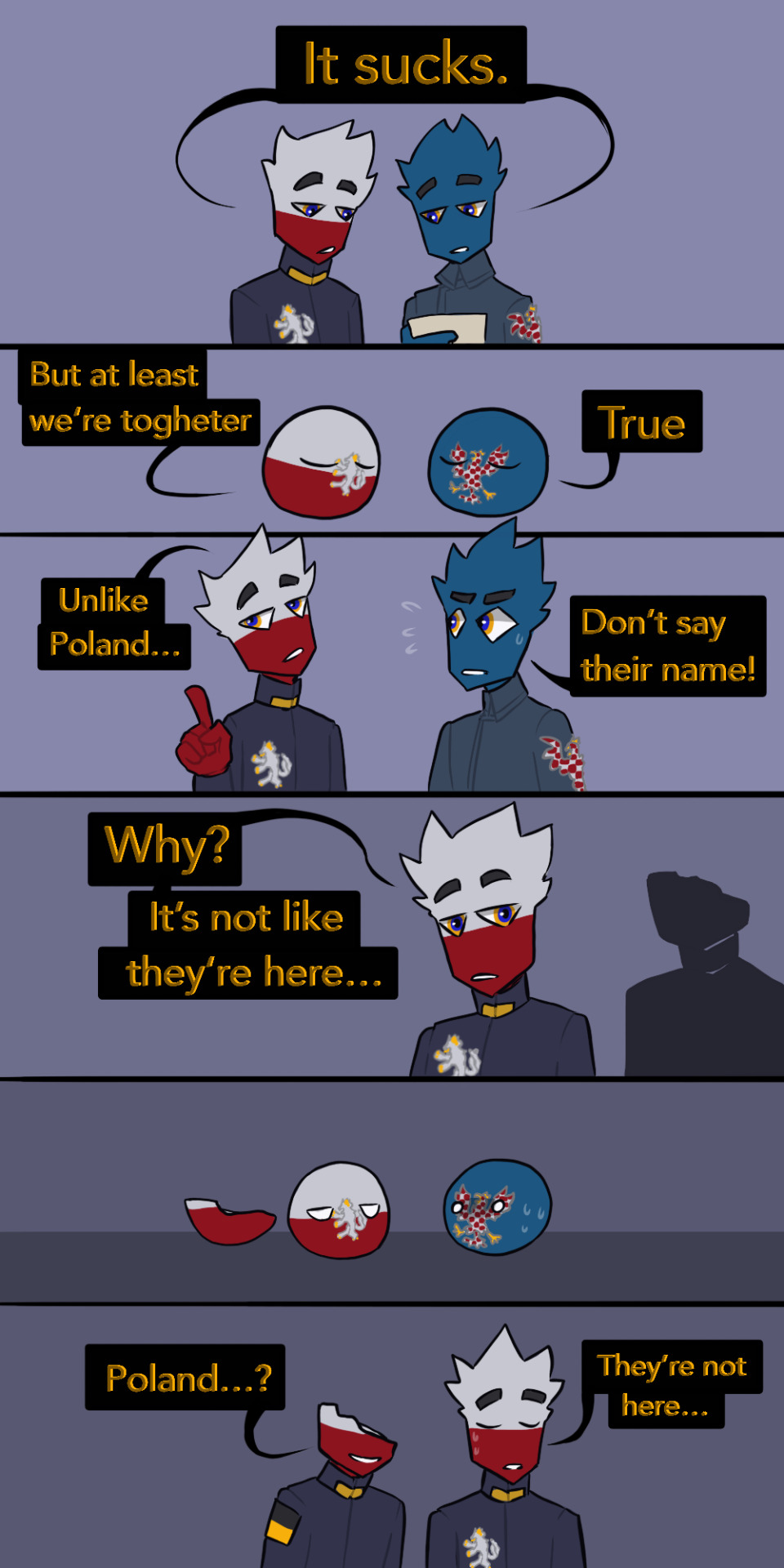

(Bohemia and Poland's flags are basically the same , so to distinguish them I used the coat of arms, also well Poland is in pieces now so it's pretty easy to spot the difference...)
(The map from where I'm basing the Ethno-linguistic parts of Austria-Hungary)

50 notes
·
View notes
Text
there is a special type of rage I feel every time westerners talk about slavic history, especially when it’s in videoessays explaining concepts tied to our history
#litchi.txt#next time someone says that cyril and metod introduced christianity to slavs in great moravia I might fly to them and slap them
4 notes
·
View notes
Text
JAMMF, 303
James Alexander Malcolm Mackenzie Fraser is today 303. Born to both strife and greatness, on Beltane Day.
Fictional characters never die for good, their energy keeps on lingering somewhere, in a corner of our heart. So, here's a heartfelt Happy Birthday to a formidable character that one day chose to possess Herself's imagination and brought us all together, in this strange digital limbo of sorts.
Despite his rock-solid appearance, JAMMF is a real chameleon. My favorite JAMMF is perhaps the least talked about one. The Diplomat. Of course.
This guy, playing chess at Versailles (in reality, it's Prague, and a sizably different kind of Baroque, but let's not nitpick, here). A wonderful metaphor for what diplomacy was, is and always will be: a sophisticated game of chess.

While in Paris, JAMMF is acting, in plain sight, as a diplomatic agent of sorts on behalf of Bonnie Prince Charlie's embryo of a government in exile. Desperately hoping and fruitlessly waiting for more. And making a very bad, emotional job of it all, when emotions are least needed, despite all those best laid plans. Still, he does exactly what a diplomat posted abroad would do. He meets all the important honchos, he brilliantly entertains all those people at his open table, he mingles with princes and beggars alike and of course, he dutifully reports in writing about all this, back to Scotland.
It is, therefore, a pity and a shame that Herself did not utter a single word, in Dragonfly in Amber, about the real Jacobite meeting place in Paris: Sorbonne's Collegium Scoticum/Scots College, or Collège des Écossais, founded in 1333, by an edict of the Parliament of Paris (what we would call today the local council) and as a belated, yet important consequence of the Auld Alliance treaty between France, Scotland and Norway:
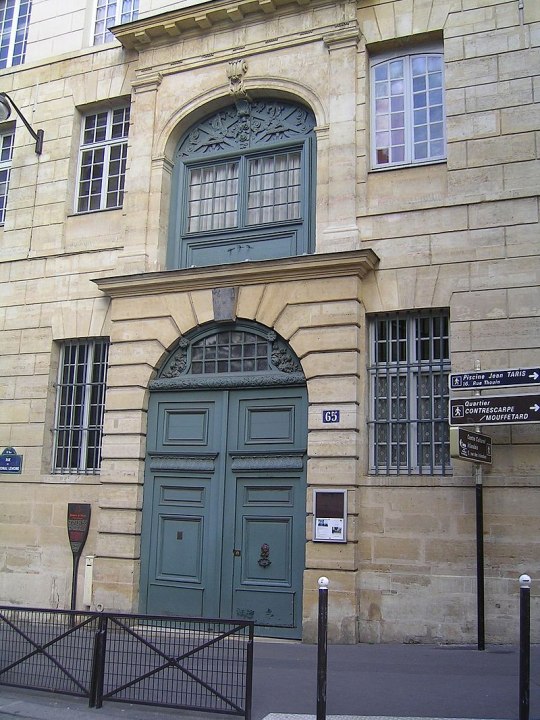
This is a place with a rich and minutely documented history, so much so that the adjoining street soon came to be known as the rue des Ecossais (Scots' Street), instead of rue des Amandiers (Almond Tree Street).
The building is still there, albeit with a different destination, a private Catholic elementary school. And a plaque inside the main building tells part of the story, in Latin:
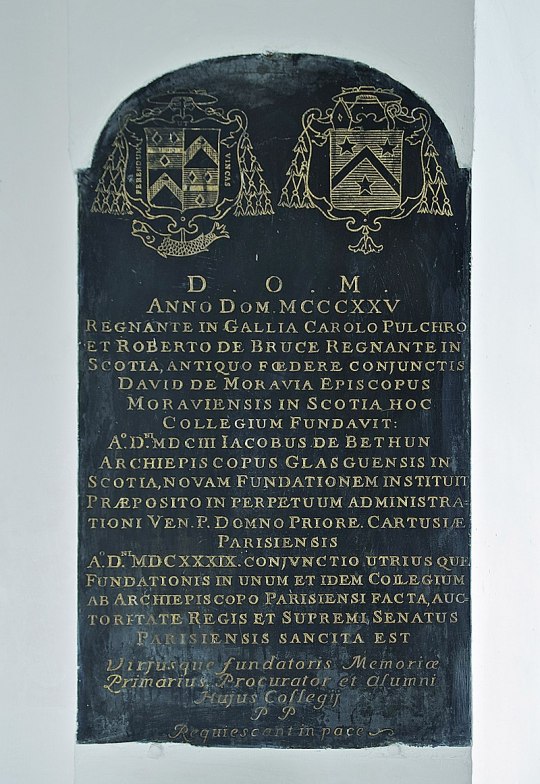
Meaning:
In 1325, under the reigns of Charles the Fair, in France and Robert the Bruce, in Scotland, David de Moravia, bishop of Murray founded this college. In 1604, Jacques de Bethun, archbishop of Glasgow made a seminary out of it, given to the perpetual administration of the Carthusian Order's Superior of Paris [later edit, forgot to translate that properly and the French version I eventually took out is incomplete, sorry!]. In 1639, the whole was placed under the authority of the King of France and the Archbishop of Paris, their supreme authority being solemnly ratified by the Parliament of Paris. In memory of the founders, the priests and the alumni, may they rest in peace!
[Later edit]: the eight year difference in records reflects the time it took for the Parliament of Paris to acknowledge the College's existence and offer its due legal protection. So: founded by the bishop of Murray in 1325 and legally authorized by the Parliament of Paris in 1333. Both dates are legit founding landmarks and can be quoted accordingly.
62 notes
·
View notes
Text
Reinhard Heydrich

These are some facts and curiosities about Reinhard Heydrich:
He was born on the 7 March 1904 in Halle.
He was often mocked in his youth as Moses Handel, as it was rumored that he had Jewish ancestors, but it was never proven.
Both his parents were passionate about music and gave birth to a lifelong passion for the violin in their son.
In 1922 he entered the navy, at the naval academy in Kiel but he was discharged because, after having had an affair with the daughter of one of his superiors, he abandoned her for a younger woman.
He join the Nazis in 1931 when Himmler offered him to be the head of the SD, the segret service in the SS. He was given that position because Himmler was impressed by his Aryan appearence, self- assurance and thorough approach to the assigniment.
At the time he wasn’t a big shoot in the Nazis: he worked in a small office and he didn’t gain many money.
After Adolf Hitler took power in 1933, Heydrich was placed in command of the Gestapo in 1934 and dealt with those organizations and people who could harm the Nazi cause.
He himself later organized the attack on the Gleiwitz radio station, called "Operation Himmler", which started the Second World War.
On 20 January 1942 Heydrich held the sadly famous conference in Wannsee in which the "Final Solution of the Jewish question" was planned.
In December 1941 he became the protector of Bohemia and Moravia, and he held a fight against the Czech resistance.
Heydrich became the ‘’de facto’’dictator of the area, ordering repression and persecution,so much that he earned the nickname The Executioner of Prague (Der Henker von Prag).
On 27 May 1942 a commando composed of members of the Czechoslovakian army in exile, trained by the British SOE made an attempt on Heydrich's life. He died on the 4th of June 1942.
To avenge Heydrich, the Nazi murdered all 192 males over the age of 15 living in the village of Lidice, near Prague, and deported all the women and children. Subsequently, all the buildings were burned, and the rubble was then removed to definitively erase the place from the geographical maps.
"Operation Reinhard" was named after Heydrich, the plan for the construction of the first three German extermination camps: Treblinka, Sobibór and Bełżec.
He was a great sport man: he like fancing and he was a horseman.
He cared about his victims as much as we care about the ant colonies in our yards
He open a bordel
He married Lina Von Osten and they had four children:
Klaus Heydrich ( 1933-1943)
Heider Heydrich (1934-)
Silke Heydrich ( 1939-)
Marte Heydrich ( 1942-)
Sources:
Wikipedia: Reinhard Heydrich
Military Wiki: Reinhard Heydrich
The Iron Heart Reinhard Heydrich by Johana Connor
HHhH by Laurent Binet.
I DON'T SUPPORT NAZISM,FASCISM OR ZIONISM IN ANY WAY, THIS IS AN EDUCATIONAL POST
54 notes
·
View notes
Photo
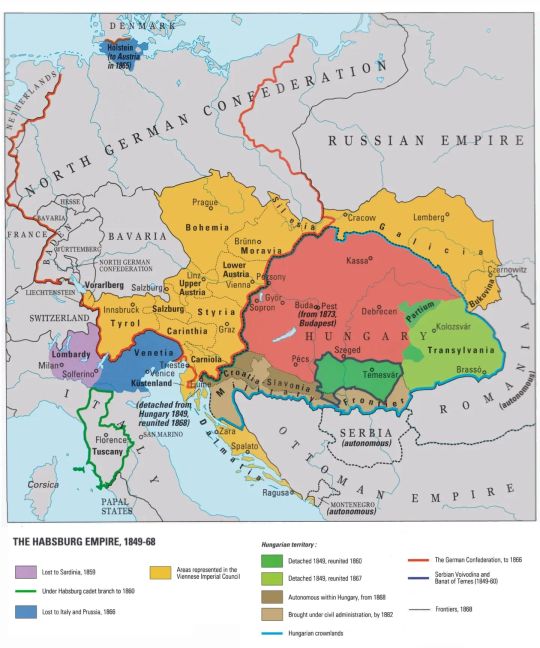
The Habsburg monarchy from 1849 to 1868
“Atlas of European history”, Times Books, 1994
via cartesdhistoire
Having defeated the revolution of 1848 in Hungary, Vienna made substantial changes to Hungarian territory: Transylvania was detached, Croatia was enlarged and the voivodship of Serbia and the Banat of Tamiš was created (November 1849).
This situation continued until the Austrian defeats in Italy in 1859 and against Prussia in 1866. After the abolition of the voivodship of Serbia and the Banat in 1860, Emperor Franz Joseph restored the autonomy of Hungary through the Compromise of 1867 (“Österreichisch-Ungarischer Ausgleich”). Hungary obtained what it demanded in 1848: a government responsible to Parliament and the management of its internal affairs, to the great dismay of the non-Magyar populations who were therefore subject to the centralizing model of Budapest.
The Compromise consists of the Constitutional Statute concerning Austria and its dependencies and the Constitutional Pact concluded between Franz Joseph and the Hungarian Nation. Indeed, the Hungarians have always seen their integration into the Habsburg monarchy as a voluntary act and not as a subjection.
The “Ausgleich” was completed in November 1868 by a Hungarian-Croatian compromise (“Nagoda”) negotiated between Budapest and the Zagreb Diet. Croatia-Slavonia now forms an autonomous kingdom within Hungary with its own administration and its Diet (“Sabor”).
Hungary recovered Transylvania in 1867 and the military borders were placed under civil administration between 1851 and 1881.
Hungary (Transleithania) brings together 20,886,000 inhabitants in a territory which is generally that of the Crown of Saint-Etienne. This is also its official name: “Country of the Crown of Saint-Étienne”. Austria (Cisleithania) is the rest of the Habsburg territory, officially named "Kingdoms and countries represented in the Imperial Diet", a more disparate group of 28,275,000 inhabitants - including the Countries of the Crown of Saint Wenceslas: Bohemia, Moravia, Silesia.
110 notes
·
View notes
Text








“Even before the leaves bud out, as the snow begins to thaw, one must invite–indeed coax–the spring to arrive. If one simply waited, Spring (being willful) might not choose to come, and then, with last year’s food bins already almost empty, one could not survive. To bring the spring proactively, Russian mothers baked bird-shaped pastries in early March and their children clambered about setting these little larks and snipes out like duck decoys on the rooftops, fence posts, and snowless patches of ground, hanging them from trees and bushes or even tossing them into the air, meanwhile singing such songs as:
Larks, Larks, Give us Summer,
We’ll give you Winter,
There’s no food left for us”
–“The Dancing Goddesses” by Elizabeth Wayland Barber
In an earlier time the Ukraine and other Slavic nations, on the Holy Day of the 40 Martyrs, (March 9, O.S; March 22, N.S.), the return of the birds in the spring was celebrated with special spring songs (vesnianky). Birds made of dough were also baked representing the larks that were migrating back to the north.
I started releasing the birds into the wild with my friend @msgraveyarddirt (who also gave me the above recipe) a few years ago. I was delighted to find this picture in a book on the traditions of the Znojmo region of Moravia (where my great-grandparents are from) earlier this year and realize that the birds are indeed one of those pan Slavic traditions:

I decided to go ahead and release my birds slightly ahead of the Spring Equinox as spring is coming very quickly here and I didn't want to wait until it was an unseasonal ritual.
These birds are not overly sweet and I removed the cloves after taking the pictures to make them safe for animals.
101 notes
·
View notes
Text

Chapter 7: Mutual Aid Amongst Ourselves (Part 1)
Popular revolts at the beginning of the State-period. — Mutual Aid institutions of the present time. — The village community; its struggles for resisting its abolition by the State. — Habits derived from the village-community life, retained in our modern villages. — Switzerland, France, Germany, Russia.
The mutual-aid tendency in man has so remote an origin, and is so deeply interwoven with all the past evolution of the human race, that it has been maintained by mankind up to the present time, notwithstanding all vicissitudes of history. It was chiefly evolved during periods of peace and prosperity; but when even the greatest calamities befell men — when whole countries were laid waste by wars, and whole populations were decimated by misery, or groaned under the yoke of tyranny — the same tendency continued to live in the villages and among the poorer classes in the towns; it still kept them together, and in the long run it reacted even upon those ruling, fighting, and devastating minorities which dismissed it as sentimental nonsense. And whenever mankind had to work out a new social organization, adapted to a new phase of development, its constructive genius always drew the elements and the inspiration for the new departure from that same ever-living tendency. New economical and social institutions, in so far as they were a creation of the masses, new ethical systems, and new religions, all have originated from the same source, and the ethical progress of our race, viewed in its broad lines, appears as a gradual extension of the mutual-aid principles from the tribe to always larger and larger agglomerations, so as to finally embrace one day the whole of mankind, without respect to its diverse creeds, languages, and races.
After having passed through the savage tribe, and next through the village community, the Europeans came to work out in medieval times a new form of organization, which had the advantage of allowing great latitude for individual initiative, while it largely responded at the same time to man’s need of mutual support. A federation of village communities, covered by a network of guilds and fraternities, was called into existence in the medieval cities. The immense results achieved under this new form of union — in well-being for all, in industries, art, science, and commerce — were discussed at some length in two preceding chapters, and an attempt was also made to show why, towards the end of the fifteenth century, the medieval republics — surrounded by domains of hostile feudal lords, unable to free the peasants from servitude, and gradually corrupted by ideas of Roman Cæsarism — were doomed to become a prey to the growing military States.
However, before submitting for three centuries to come, to the all-absorbing authority of the State, the masses of the people made a formidable attempt at reconstructing society on the old basis of mutual aid and support. It is well known by this time that the great movement of the reform was not a mere revolt against the abuses of the Catholic Church. It had its constructive ideal as well, and that ideal was life in free, brotherly communities. Those of the early writings and sermons of the period which found most response with the masses were imbued with ideas of the economical and social brotherhood of mankind. The “Twelve Articles” and similar professions of faith, which were circulated among the German and Swiss peasants and artisans, maintained not only every one’s right to interpret the Bible according to his own understanding, but also included the demand of communal lands being restored to the village communities and feudal servitudes being abolished, and they always alluded to the “true” faith — a faith of brotherhood. At the same time scores of thousands of men and women joined the communist fraternities of Moravia, giving them all their fortune and living in numerous and prosperous settlements constructed upon the principles of communism.[251] Only wholesale massacres by the thousand could put a stop to this widely-spread popular movement, and it was by the sword, the fire, and the rack that the young States secured their first and decisive victory over the masses of the people.[252]
For the next three centuries the States, both on the Continent and in these islands, systematically weeded out all institutions in which the mutual-aid tendency had formerly found its expression. The village communities were bereft of their folkmotes, their courts and independent administration; their lands were confiscated. The guilds were spoliated of their possessions and liberties, and placed under the control, the fancy, and the bribery of the State’s official. The cities were divested of their sovereignty, and the very springs of their inner life — the folkmote, the elected justices and administration, the sovereign parish and the sovereign guild — were annihilated; the State’s functionary took possession of every link of what formerly was an organic whole. Under that fatal policy and the wars it engendered, whole regions, once populous and wealthy, were laid bare; rich cities became insignificant boroughs; the very roads which connected them with other cities became impracticable. Industry, art, and knowledge fell into decay. Political education, science, and law were rendered subservient to the idea of State centralization. It was taught in the universities and from the pulpit that the institutions in which men formerly used to embody their needs of mutual support could not be tolerated in a properly organized State; that the State alone could represent the bonds of union between its subjects; that federalism and “particularism” were the enemies of progress, and the State was the only proper initiator of further development. By the end of the last century the kings on the Continent, the Parliament in these isles, and the revolutionary Convention in France, although they were at war with each other, agreed in asserting that no separate unions between citizens must exist within the State; that hard labour and death were the only suitable punishments to workers who dared to enter into “coalitions.” “No state within the State!” The State alone, and the State’s Church, must take care of matters of general interest, while the subjects must represent loose aggregations of individuals, connected by no particular bonds, bound to appeal to the Government each time that they feel a common need. Up to the middle of this century this was the theory and practice in Europe. Even commercial and industrial societies were looked at with suspicion. As to the workers, their unions were treated as unlawful almost within our own lifetime in this country and within the last twenty years on the Continent. The whole system of our State education was such that up to the present time, even in this country, a notable portion of society would treat as a revolutionary measure the concession of such rights as every one, freeman or serf, exercised five hundred years ago in the village folkmote, the guild, the parish, and the city.
The absorption of all social functions by the State necessarily favoured the development of an unbridled, narrow-minded individualism. In proportion as the obligations towards the State grew in numbers the citizens were evidently relieved from their obligations towards each other. In the guild — and in medieval times every man belonged to some guild or fraternity two “brothers” were bound to watch in turns a brother who had fallen ill; it would be sufficient now to give one’s neighbour the address of the next paupers’ hospital. In barbarian society, to assist at a fight between two men, arisen from a quarrel, and not to prevent it from taking a fatal issue, meant to be oneself treated as a murderer; but under the theory of the all-protecting State the bystander need not intrude: it is the policeman’s business to interfere, or not. And while in a savage land, among the Hottentots, it would be scandalous to eat without having loudly called out thrice whether there is not somebody wanting to share the food, all that a respectable citizen has to do now is to pay the poor tax and to let the starving starve. The result is, that the theory which maintains that men can, and must, seek their own happiness in a disregard of other people’s wants is now triumphant all round in law, in science, in religion. It is the religion of the day, and to doubt of its efficacy is to be a dangerous Utopian. Science loudly proclaims that the struggle of each against all is the leading principle of nature, and of human societies as well. To that struggle biology ascribes the progressive evolution of the animal world. History takes the same line of argument; and political economists, in their naive ignorance, trace all progress of modern industry and machinery to the “wonderful” effects of the same principle. The very religion of the pulpit is a religion of individualism, slightly mitigated by more or less charitable relations to one’s neighbours, chiefly on Sundays. “Practical” men and theorists, men of science and religious preachers, lawyers and politicians, all agree upon one thing — that individualism may be more or less softened in its harshest effects by charity, but that it is the only secure basis for the maintenance of society and its ulterior progress.
It seems, therefore, hopeless to look for mutual-aid institutions and practices in modern society. What could remain of them? And yet, as soon as we try to ascertain how the millions of human beings live, and begin to study their everyday relations, we are struck with the immense part which the mutual-aid and mutual-support principles play even now-a-days in human life. Although the destruction of mutual-aid institutions has been going on in practice and theory, for full three or four hundred years, hundreds of millions of men continue to live under such institutions; they piously maintain them and endeavour to reconstitute them where they have ceased to exist. In our mutual relations every one of us has his moments of revolt against the fashionable individualistic creed of the day, and actions in which men are guided by their mutual aid inclinations constitute so great a part of our daily intercourse that if a stop to such actions could be put all further ethical progress would be stopped at once. Human society itself could not be maintained for even so much as the lifetime of one single generation. These facts, mostly neglected by sociologists and yet of the first importance for the life and further elevation of mankind, we are now going to analyze, beginning with the standing institutions of mutual support, and passing next to those acts of mutual aid which have their origin in personal or social sympathies.
When we cast a broad glance on the present constitution of European society we are struck at once with the fact that, although so much has been done to get rid of the village community, this form of union continues to exist to the extent we shall presently see, and that many attempts are now made either to reconstitute it in some shape or another or to find some substitute for it. The current theory as regards the village community is, that in Western Europe it has died out by a natural death, because the communal possession of the soil was found inconsistent with the modern requirements of agriculture. But the truth is that nowhere did the village community disappear of its own accord; everywhere, on the contrary, it took the ruling classes several centuries of persistent but not always successful efforts to abolish it and to confiscate the communal lands.
In France, the village communities began to be deprived of their independence, and their lands began to be plundered, as early as the sixteenth century. However, it was only in the next century, when the mass of the peasants was brought, by exactions and wars, to the state of subjection and misery which is vividly depicted by all historians, that the plundering of their lands became easy and attained scandalous proportions. “Every one has taken of them according to his powers... imaginary debts have been claimed, in order to seize upon their lands;” so we read in an edict promulgated by Louis the Fourteenth in 1667.[253] Of course the State’s remedy for such evils was to render the communes still more subservient to the State, and to plunder them itself. In fact, two years later all money revenue of the communes was confiscated by the King. As to the appropriation of communal lands, it grew worse and worse, and in the next century the nobles and the clergy had already taken possession of immense tracts of land — one-half of the cultivated area, according to certain estimates — mostly to let it go out of culture.[254] But the peasants still maintained their communal institutions, and until the year 1787 the village folkmotes, composed of all householders, used to come together in the shadow of the bell-tower or a tree, to allot and re-allot what they had retained of their fields, to assess the taxes, and to elect their executive, just as the Russian mir does at the present time. This is what Babeau’s researches have proved to demonstration.[255]
The Government found, however, the folkmotes “too noisy,” too disobedient, and in 1787, elected councils, composed of a mayor and three to six syndics, chosen from among the wealthier peasants, were introduced instead. Two years later the Revolutionary Assemblé e Constituante, which was on this point at one with the old régime, fully confirmed this law (on the 14th of December, 1789), and the bourgeois du village had now their turn for the plunder of communal lands, which continued all through the Revolutionary period. Only on the 16th of August, 1792, the Convention, under the pressure of the peasants’ insurrections, decided to return the enclosed lands to the communes;[256] but it ordered at the same time that they should be divided in equal parts among the wealthier peasants only — a measure which provoked new insurrections and was abrogated next year, in 1793, when the order came to divide the communal lands among. All commoners, rich and poor alike, “active” and “inactive.”
These two laws, however, ran so much against the conceptions of the peasants that they were not obeyed, and wherever the peasants had retaken possession of part of their lands they kept them undivided. But then came the long years of wars, and the communal lands were simply confiscated by the State (in 1794) as a mortgage for State loans, put up for sale, and plundered as such; then returned again to the communes and confiscated again (in 1813); and only in 1816 what remained of them, i.e. about 15,000,000 acres of the least productive land, was restored to the village communities.[257] Still this was not yet the end of the troubles of the communes. Every new régime saw in the communal lands a means for gratifying its supporters, and three laws (the first in 1837 and the last under Napoleon the Third) were passed to induce the village communities to divide their estates. Three times these laws had to be repealed, in consequence of the opposition they met with in the villages; but something was snapped up each time, and Napoleon the Third, under the pretext of encouraging perfected methods of agriculture, granted large estates out of the communal lands to some of his favourites.
As to the autonomy of the village communities, what could be retained of it after so many blows? The mayor and the syndics were simply looked upon as unpaid functionaries of the State machinery. Even now, under the Third Republic, very little can be done in a village community without the huge State machinery, up to the préfet and the ministries, being set in motion. It is hardly credible, and yet it is true, that when, for instance, a peasant intends to pay in money his share in the repair of a communal road, instead of himself breaking the necessary amount of stones, no fewer than twelve different functionaries of the State must give their approval, and an aggregate of fifty-two different acts must be performed by them, and exchanged between them, before the peasant is permitted to pay that money to the communal council. All the remainder bears the same character.[258]
What took place in France took place everywhere in Western and Middle Europe. Even the chief dates of the great assaults upon the peasant lands are the same. For England the only difference is that the spoliation was accomplished by separate acts rather than by general sweeping measures — with less haste but more thoroughly than in France. The seizure of the communal lands by the lords also began in the fifteenth century, after the defeat of the peasant insurrection of 1380 — as seen from Rossus’s Historia and from a statute of Henry the Seventh, in which these seizures are spoken of under the heading of “enormitees and myschefes as be hurtfull... to the common wele.”[259] Later on the Great Inquest, under Henry the Eighth, was begun, as is known, in order to put a stop to the enclosure of communal lands, but it ended in a sanction of what had been done.[260] The communal lands continued to be preyed upon, and the peasants were driven from the land. But it was especially since the middle of the eighteenth century that, in England as everywhere else, it became part of a systematic policy to simply weed out all traces of communal ownership; and the wonder is not that it has disappeared, but that it could be maintained, even in England, so as to be “generally prevalent so late as the grandfathers of this generation.”[261] The very object of the Enclosure Acts, as shown by Mr. Seebohm, was to remove this system,[262] and it was so well removed by the nearly four thousand Acts passed between 1760 and 1844 that only faint traces of it remain now. The land of the village communities was taken by the lords, and the appropriation was sanctioned by Parliament in each separate case.
In Germany, in Austria, in Belgium the village community was also destroyed by the State. Instances of commoners themselves dividing their lands were rare,[263] while everywhere the States coerced them to enforce the division, or simply favoured the private appropriation of their lands. The last blow to communal ownership in Middle Europe also dates from the middle of the eighteenth century. In Austria sheer force was used by the Government, in 1768, to compel the communes to divide their lands — a special commission being nominated two years later for that purpose. In Prussia Frederick the Second, in several of his ordinances (in 1752, 1763, 1765, and 1769), recommended to the Justizcollegien to enforce the division. In Silesia a special resolution was issued to serve that aim in 1771. The same took place in Belgium, and, as the communes did not obey, a law was issued in 1847 empowering the Government to buy communal meadows in order to sell them in retail, and to make a forced sale of the communal land when there was a would-be buyer for it.[264]
In short, to speak of the natural death of the village communities in virtue of economical laws is as grim a joke as to speak of the natural death of soldiers slaughtered on a battlefield. The fact was simply this: The village communities had lived for over a thousand years; and where and when the peasants were not ruined by wars and exactions they steadily improved their methods of culture. But as the value of land was increasing, in consequence of the growth of industries, and the nobility had acquired, under the State organization, a power which it never had had under the feudal system, it took possession of the best parts of the communal lands, and did its best to destroy the communal institutions.
However, the village-community institutions so well respond to the needs and conceptions of the tillers of the soil that, in spite of all, Europe is up to this date covered with living survivals of the village communities, and European country life is permeated with customs and habits dating from the community period. Even in England, notwithstanding all the drastic measures taken against the old order of things, it prevailed as late as the beginning of the nineteenth century. Mr. Gomme — one of the very few English scholars who have paid attention to the subject — shows in his work that many traces of the communal possession of the soil are found in Scotland, “runrig” tenancy having been maintained in Forfarshire up to 1813, while in certain villages of Inverness the custom was, up to 1801, to plough the land for the whole community, without leaving any boundaries, and to allot it after the ploughing was done. In Kilmorie the allotment and re-allotment of the fields was in full vigour “till the last twenty-five years,” and the Crofters’ Commission found it still in vigour in certain islands.[265] In Ireland the system prevailed up to the great famine; and as to England, Marshall’s works, which passed unnoticed until Nasse and Sir Henry Maine drew attention to them, leave no doubt as to the village-community system having been widely spread, in nearly all English counties, at the beginning of the nineteenth century.[266] No more than twenty years ago Sir Henry Maine was “greatly surprised at the number of instances of abnormal property rights, necessarily implying the former existence of collective ownership and joint cultivation,” which a comparatively brief inquiry brought under his notice.[267] And, communal institutions having persisted so late as that, a great number of mutual-aid habits and customs would undoubtedly be discovered in English villages if the writers of this country only paid attention to village life.[268]
#organization#revolution#mutual aid#anarchism#daily posts#communism#anti capitalist#anti capitalism#late stage capitalism#anarchy#anarchists#libraries#leftism#social issues#economy#economics#climate change#anarchy works#environmentalism#environment#solarpunk#anti colonialism#a factor of evolution#petr kropotkin
14 notes
·
View notes
Note
surprised that guy even knows what cyrillic is tbh. saw many americans call it "russian alphabet"
i hate that bc cyrillics didnt even originate in russia lol it was made by ćiril and metod to spread christianity to slavs in great moravia which included parts of quite few slav countries (serbia, croatia (tho croatia used glagoljica, the alphabet made before ćirilica), czech, poland, bulgaria...) but not russia. russia got ćirilica later.
also russian and serbian cyrillics are different lol i always get confused when i see a post online and i go read it and then i realize the letters are weird 🤨
12 notes
·
View notes
Text



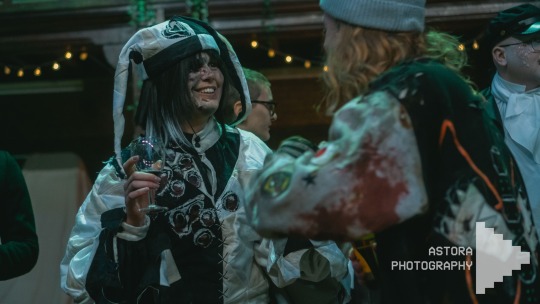




All Hallow's Eve LARP by L'Chaim Games - Meiserich (my ghost OC, yes he was shot in the face)
aka "Ghost Ball! Ghost Ball!", London, 02.12.23
Photos by Astora Photography on FB
My jester took so long to make because I took inspiration from Diana Wynne Jones' 'Howl's Moving Castle' where Sophie cuts up Howl's suit into triangles and then sews it back together, so Meiserich's outer layer is all triangles.
I wanted to make Meiserich out of scraps from previous projects, so virtually all of the cost of the outfit is the time that went into it. I worked on him for six months in virtually any free minute I could find the energy for. But it was worth it.
It's not 100% historically accurate, but this outfit was designed to double as a cosplay for the Fool from Robin Hobb's 'Assassin's Apprentice' and the rest of the Farseer Trilogy. (I still have to read the other books! No spoilers please though I have seen some sneak peeks thanks to fanart <3)
More about Meiserich as a character under the cut!
Meiserich (anglicised pronunciation: My-Zer-Rick) is a colloquial German name for galium odoratum, sweet woodruff. It's a flavour you can get commonly in German desserts and schnapps (Waldmeister), but I've never come across the flavour in the UK.
Meiserich is a jester from the early 1400's and lived in a part of the Holy Roman Empire that is now Germany, namely within the Roman Catholic Diocese of Münster. At the court of Droste zur Aa Meiserich had a close relationship with Lady Klara of the keep. In 1412 this court took part in a knights' jousting tournament in Buda where the future Holy Roman Emperor Sigismund was also in attendance. Whilst there, through social occasions, Lady Klara found out and obtained evidence that Sigismund was the one who poisoned the previous King of Germany, Jobst of Moravia. She confided in Meiserich what had happened.
It comes to light that Lady Klara knows too much, so Sigismund sends soldiers to Münster to besiege the keep. Meiserich encourages his Lady to run and hide with the evidence of the poisoning. As a jester it was also Meiserich's job to act as a messenger and diplomat at times. However, the siege negotiations failed, he was shot dead with an early arquebus design and the castle was fired upon with trebuchets. Lady Klara initially survived in the rubble in an airpocket but ultimately suffocated.
Meiserich usually haunts the ruins of the castle keep he used to live in. It is now a tourist destination and he likes to tease the tourists. He also eavesdrops and through them and the keep staff learns of other things going on in the world. He has not forgotten about Lady Klara and wants to reveal the truth she uncovered to the world.
Please note: The poisoning plot is fictional, Sigismund doing this is something I made up based on some Wikipedia reading I did.
His wish to have fulfilled at the LARP was to have the keep in Münster renovated and restored, revealing the buried corpse of Lady Klara. In her hand are a vial of poison and a letter proving Sigismund was the one who poisoned the previous king of Germany, Jobst of Moravia. It will be a joy for the historians and great to hear the tour guides at the keep bring this up in perpetuity.
And he got his wish fulfilled at the game! I'm so happy. Monsieur Roc Flamboyant (a French noble, 1600's) was touched enough by Meiserich's story and devotion to Lady Klara that he made the wish for Meiserich. I could not have asked for a better end to this game.
Shout out to the podcasts that helped me put together Meiserich as a character:
Gone Medieval by History Hit
We're Not So Different - esp. episode "Medieval Fail Sons: Wenceslas IV & Sigismund"
Weird Medieval Guys - esp. episode "Sieging for Dummies"
The Court Jester by Kleio Pethainou
I'm glad I picked the early 1400's for Meiserich's death, this is still before the Western printing press, Columbus sailing off to the detriment of many, the fall of Constantinople, and the big witch hunting craze, so he died in a bygone world on the cusp of the Early Modern Period.
If I could give him one power like in BBC Ghosts, I'd say that the two bells on his hat are audible to the living.

14 notes
·
View notes
Text

Archeopark Mikulčice – Kopčany, Moravia, Czech Republic
Decorative belt endings in the shape of a miniature book codex. Found in tomb No 505 near the trinave basilica.
Nákončí opasku v podobě miniaturního knižního kodexu. Nález z hrobu č. 505 u trojlodní baziliky.
Riemenzunge in Form eines Miniaturbuchkodex. Fund aus Grab Nr. 505 bei der dreischiffigen Basilika.
#Archeopark#Mikulčice–Kopčany#Mikulčice–Valy#Moravia#Czech Republic#Velká Morava#Great Moravia#Großmähren#Altmähren#Stará Morava#decorative#belt endings#miniature book codex#nákončí opasku#miniaturní knižní kodex#Riemenzunge#Miniaturbuchkodex
3 notes
·
View notes
Photo
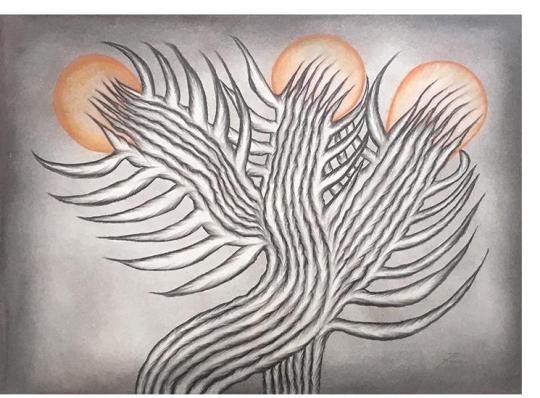
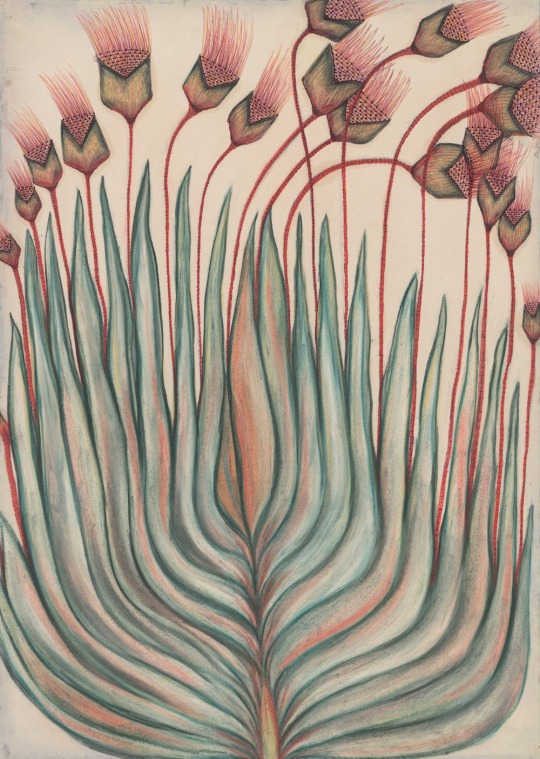


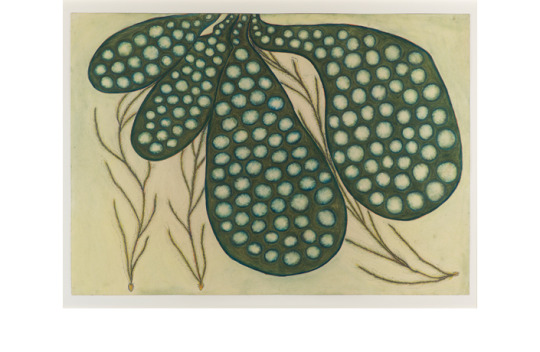

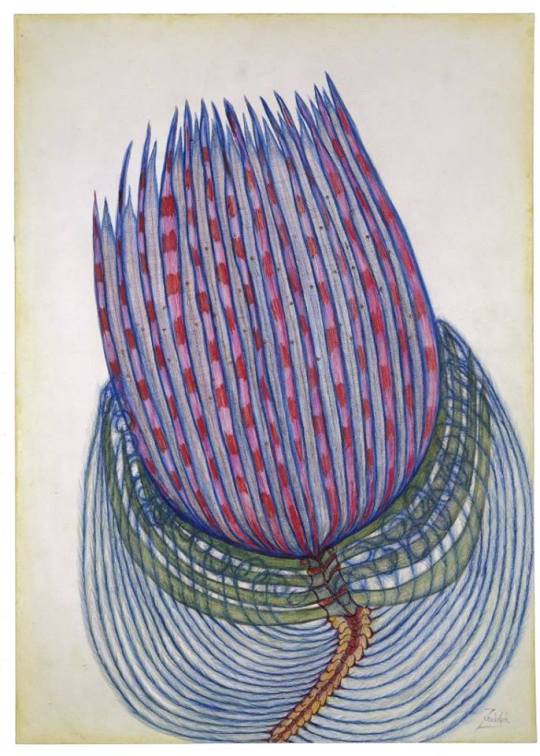
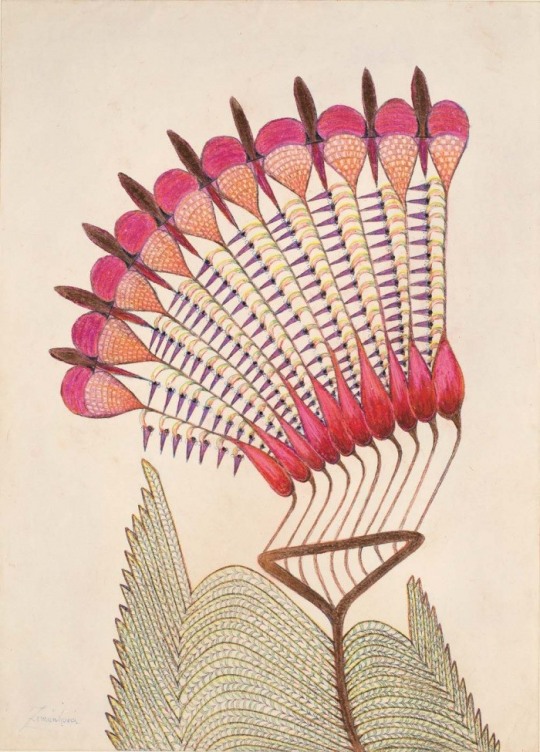


Every time I read about Czech artist Anna Zemankova (1908-1986), I select a few pictures to post.
"I grow flower which grow nowhere else," used to say Anna Zemankova. Under the Cold War in Prague, housewife Anna Zemankova started drawing from over the age of fifty. It was her son, a sculptor, who suggested his mother suffering from melancholia to take up drawing.
Every morning from 4am to 7am - while the rest of the family was still fast asleep - she drew guided by her favorite classical music. Her botanical drawings drawn in pastel are adorned with handicraft-like decoration such as metal fragments producing a bumpy effect, glued fabric and embroidery.Anna Zemánková was born in Olomouc, Moravia, then a province of the Austro-Hungarian Monarchy. While still a child she showed a great fondness for drawing; her father, however, had no sympathy for her predisposition and she became a dental technician.
In 1933, she married an army officer and stopped working to devote herself to her family. The couple had three sons, the older of whom died at the age of four, and later, a daughter. A loving mother, she spent all her time taking care of her family. After World War Two, the family moved to Prague.
In 1950 she began to suffer from depression, and because of diabetes, had to have both legs amputated.She was over 50 when – perhaps in a return to her childhood dreams – she began painting daily, working every day from four to seven in the morning to sketch spontaneous drawings inspired by plants. It was in these early hours that she felt she could capture magnetic forces. When she set about drawing, she had no idea of the final shape the work would take, saying, “It all works by itself … there is no need to think.
”Her strikingly detailed works with a compelling rhythm of spirals, arabesques and geometric shapes make Zemánková a major figure in art brut. They are to be found in the most prestigious art brut collections and Zemánková is to be duly honoured at the international pavilion of the Venice Biennale 2013.
https://christianberst.com/en/artists/anna-zemankova
https://www.frieze.com/.../incandescent-botany-overlooked...
34 notes
·
View notes
Text
Please reblog for a bigger sample size!
If you have any fun fact about Moravia, please tell us and I'll reblog it!
Be respectful in your comments. You can criticize a government without offending its people.
5 notes
·
View notes
Text
Zagreb is the capital city of Croatia. But till the XVI-th century wasn't even part of Croatia. It was one of capital cities of Kingdom of Slavonia.
During Roman Empire, today's northern part of Croatia was roman county Panonia Minor. After the fall of the Western Roman Empire, franks acquired the title of Roman Empire and transfered former counties to duchies, vasals of frank kings. So Panonia Minor became "Duchy between Sava and Drava" (rivers).
During VI-th and VII-th century slavic people settled eastern duchies of franks empire: Bohemia (Czechia), Moravia, Nitra (Slovakia), Carantania (Körnten in Austria and Koroška in Slovenia), Styria (Steiern/Štajerska), Carinthia (Kranjska), Duchy between Sava and Drava, Croatia, Zahumlje, Duklja, Raška. In the IX-th century, all that duchies except the last four on Balkan, united under the same king independent from franks, with the capital in Brno. Latin name for that kingdom was Sclavonia, but it was better known as The Great Moravia (Velka/Velika Moravska).
In the X-th century hungarians came to Panonia and practicaly cutted the kingdom to two parts. From that time is Duchy between Sava and Drava know as Duchy of Slavonia, from latin name Sclavonia for the former kingdom. Hungarian name for that duchy, later kingdom was Slovenia and citizens call it Slovenje. For the same reason probably Slovakia today has it's name, called by citizens Slovensko.
On the begining of the XVI-th century Kingdom of Slavonia became part of the Habsburg Empire, later also Croatia. As about 90% of Slavonia and 90% of Croatia was occupated by Turkey, Habsburgs decided to unite two kingdoms with the capital Zagreb (Agram), so they can easier organize defence. Till 1914. official name was Kingdom of Croatia and Slavonia.
In north Croatia, former Kingdom of Slavonia, is spoken so called kaikavian dialect. That dialect is now much more close to croatian language, than it was in history, because of influence of official language, but still people from southern Croatia don't understand about 30% of that dialect, while slovenians understand all. All differences from croatian language is actualy slovenian words,so it is obvious that kaikavian is actualy dialect of slovenian language.
Today's Slovenia wasn't known under this name till the end of the IIWW. That were three duchies: Carantania, Carinthia and Styria. The first known (written) slovenian duke was Valuk, duke of Carantania in VII-th century. During history Carantania and Styria were populated by german people, so after the IWW slovenians were 42% of population in Carantania. Bigger parts of Carantania and Styria are now in Austria, while smaller parts in Slovenia.
In the XVI-th century many towns in Carantania, Carinthia and Styria changed names to emphasize it's slovenian identity: Gradec became Slovenj Gradec, Bistrica became Slovenska Bistrica, and so on. On the same time, in Zagreb was pressed the first book. It was about world history and on the first page is written that it is in slovenian language (v slouenskem jazyku). So it is obvious that people in Kingdom of Slavonia, and duchies of Carinthia, Carantania and Styria shared the same identity and language.
I was born in Zagreb, I speak kaikavian dialect, my father fill to be croat, as well as my mother when was still alive. So I also every time declare myself as croat. Most people in northern Croatia fill to be croats, and that should be respected. But it is good to know that we actualy have slovenian roots.
25 notes
·
View notes